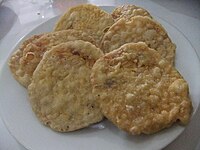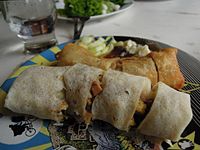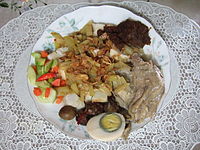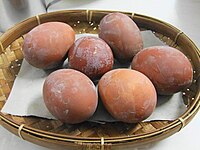Translations:Javanese cuisine/35/en
Jump to navigation
Jump to search
Common Javanese dishes
These common Javanese dishes can be found throughout Java.
- Apem, traditional cake of steamed dough made of rice flour, coconut milk, yeast and palm sugar, usually served with grated coconut.
- Ayam bumbu rujak, chicken dish made from chicken meat which is still young and uses a red basic spice then grilled. A red base is a spice made from salt, garlic, onion, and red chili.
- Ayam goreng, fried chicken dish consisting of chicken deep fried in oil with various spices.
- Ayam kecap, chicken simmered or braised in sweet soy sauce.
- Bakmi jawa, wheat based noodle, generally prepared and topped with minced chicken seasoned in soy sauce, green vegetables and a bowl of broth.
- Bakso, bakso literally means meatball. Beef or chicken meatballs, usually served in a bowl of broth with yellow noodles, rice vermicelli, vegetables, tofu, green cabbage, bean sprout, sprinkled with fried shallots and celery.
- Bakwan, fried meal consisting of vegetables and batter. Bakwan usually refers to a vegetable fritter snack, commonly sold with gorengan.
- Bergedel, fried patties, made of ground potatoes, minced meat, peeled and ground corn or tofu, or minced fish.
- Bergedel jagung, corn fritters.
- Botok, a dish made from shredded coconut flesh which has been squeezed of its coconut milk, often mixed with other ingredients such as vegetable or fish, and wrapped in banana leaf and steamed.
- Brengkesan, fish, meat, tofu, anchovy or mushroom ingredients cooked inside a banana-leaf package.
- Bubur ayam, rice congee with shredded chicken meat served with some condiments and cake.
- Bubur kacang hijau, sweet dessert made from mung beans porridge with coconut milk and palm sugar or cane sugar. The beans are boiled till soft, and sugar and coconut milk are added.
- Bubur ketan hitam, sweet dessert made from black glutinous rice porridge with coconut milk and palm sugar or cane sugar. The black glutinous rice are boiled until soft, and sugar and coconut milk are added.
- Bubur sumsum, white congee made from rice flour and eaten with brown sugar sauce.
- Buntil, a traditional Javanese dish of scraped coconut meat mixed with anchovies and spices, wrapped in a papaya leaf, then boiled in coconut milk.
- Cah kangkung, stir fried water spinach.
- Dawet, an iced sweet dessert that contains droplets of green rice flour jelly, coconut milk and palm sugar syrup.
- Donat jawa, Javanese-style of ring-shaped fritter made from cassava with savoury taste.
- Garang asem, chicken dish cooked using banana leaves and dominated by sour and spicy flavor.
- Gorengan, assorted fritters such as tempeh, tofu, yam, sweet potato, cassava, and chopped vegetables.
- Gule, a type of soupy curry-like dishes that could be made from various ingredients; meats, fish or vegetables. The gule that popular in Javanese cuisine both are gule kambing (made of goat or mutton) and gule ayam (made of chicken).
- Gule ayam, chicken cooked in a curry-like coconut milk soup.
- Gule kambing, mutton cooked in a curry-like coconut milk soup.
- Iga penyet (lit. squeeze ribs), fried beef spare ribs served with spicy sambal terasi. The fried beef ribs is squeezed against a mortar filled with sambal, and usually served with lalab vegetables and steamed rice.
- Ikan asin, salted and sun-dried fishes of various species.
- Jenang, sweet toffee-like sugar palm-based confection, made from coconut milk, jaggery, and rice flour, and is sticky, thick, and sweet.
- Kare, the Javanese adaptation of curry dishes. Just like gulai, it could be made from various ingredients; meats or vegetables.
- Klepon, glutinous rice balls stuffed with palm sugar, colored green using pandanus leaf, and rolled in fresh grated coconut.
- Keripik tempe, tempeh chips, made from thinly sliced, lightly battered, then deep fried tempeh (soybean cake).
- Kupat, rice dumpling made from rice packed inside a diamond-shaped container of woven palm leaf pouch.
- Kwetiau ayam, boiled flat noodle with diced chicken.
- Kwetiau goreng, stir fried flat noodle dish.
- Lepet, sticky rice dumpling mixed with peanuts cooked with coconut milk and packed inside a janur (young coconut leaf) or palm leaf.
- Lontong, pressed rice cake inside banana wrapping.
- Lumpia, spring roll made of thin paper-like or crepe-like pastry skin called "lumpia wrapper" enveloping savory or sweet fillings.
- Lotek, almost identical to gado-gado, but sweeter. It is similar to pecel, but includes different vegetables as well as boiled egg slices and a garnish of fish or shrimp crackers and emping (Gnetum gnemon L. nut, flattened, dried, and fried into small thin crackers).
- Martabak, stuffed pancake or pan-fried bread, sometimes filled with beef and scallions. Usually served with sambals and acar.
- Mie ayam, chicken bakmi dish of seasoned yellow wheat noodles topped with diced chicken meat.
- Mie bakso, bakso served with yellow noodles and rice vermicelli
- Mie goreng, spicy fried noodle dish seasoned in sweet soy sauce. The popular one is mie goreng jawa.
- Mie pangsit, noodle soup dish served with soft-boiled wonton.
- Mie rebus, famous noodle dish which consists of noodles, salt and egg, served with a tangy, spicy and sweet potato-based sauce.
- Nasi ambeng, fragrant Javanese rice dish that consists of steamed white rice, chicken curry or chicken stewed in soy sauce, beef or chicken rendang, fried sambal, urap, bergedel, and serundeng.
- Nasi goreng (lit. fried rice), Javanese-style of Indonesian fried rice.
- Nasi goreng jawa, fried rice dish uses sambal ulek as seasoning and has a spicy taste.
- Nasi kare (lit. curry rice), curry rice dish consists of steamed white rice, lontong or ketupat, curry, acar, fried shallots and sambals.
- Nasi kuning, similar to nasi rames or nasi campur, but the rice is cooked in coconut milk and colored bright yellow using turmeric and scented with lemongrass and kaffir lime leaves.
- Nasi rames, rice with accompaniments, usually some curried vegetable stew (sayur lodeh), a selection of cooked fish or chicken or meat and offal pieces, and a dollop of spicy sambal.
- Pangsit, wonton filled with vegetables, chicken or shrimp. It can be dry or wet.
- Pecel, a type of peanut sauce with chili
- Petis, black-colored shrimp paste.
- Putu, traditional cylindrical-shaped and green-colored steamed cake, made of rice flour called suji and colored green with extract acquired from pandan leaf, filled with palm sugar, and steamed in bamboo tubes, hence its name, and served with grated coconut.
- Puyonghai, omelette dish made from the mixture of vegetables such as carrots, bean sprouts, and cabbages, mixed with meats such as crab meat, shrimp, or minced chicken.
- Rempeyek, deep-fried savoury Javanese cracker made from flour (usually rice flour) with other ingredients, bound or coated by crispy flour batter. The most common type of rempeyek is peanut peyek.
- Rengginang, thick rice cracker, made from cooked glutinous sticky rice and seasoned with spices, made into a flat and rounded shape, and then sun-dried. The sun-dried rengginang is deep fried with ample cooking oil to produce a crispy rice cracker.
- Roti bakar (lit. grilled bread), Javanese-style of toast sandwich consisting of two slice of breads and the filling, usually hagelslag or jam.
- Rujak, traditional fruit and vegetable salad dish. There are many kinds of rujak.
- Sambal, chili sauce or paste typically made from a mixture of a variety of chili peppers with secondary ingredients such as shrimp paste, garlic, ginger, shallot, scallion, palm sugar, and lime juice. Sambal has many various types.
- Satay, skewered grilled meat is a common dish in Java. The Javanese variants are sate Tegal, sate Ambal, sate Solo, sate buntel, sate Madura, sate Ponorogo, etc.
- Sayur bening, spinach and corn in clear soup flavoured with temu kunci.
- Sayur lodeh, assorted vegetables, stewed in coconut milk.
- Semur jawa, meat (mainly beef or chicken) or vegetable (mainly potato or eggplant) stew, that is braised in thick brown gravy. The main ingredient used in semur gravy is sweet soy sauce, shallots, onions, garlic, ginger, candlenut, nutmeg and cloves, sometimes pepper, coriander, cumin and cinnamon might be added.
- Serabi, rice pancake that is made from rice flour with coconut milk or shredded coconut as an emulsifier.
- Sop buntut, oxtail soup.
- Soto, this Indonesian soup dish is also a common dish in Java. The Javanese variants are common soto ayam and soto babat (tripe), soto Kudus, soto Madura, soto Lamongan, etc.
- Tahu, fermented soy food basically a soy milk cheese. It can be fried, stir fried, stewed, as soup ingredient, even also for sweets.
- Tahu goreng, deep fried tofu prepared with some condiments, such as shrimp paste, sambal, fried shallots, mayonnaise or soy sauce.
- Tapai, traditional fermented preparation of rice or other starchy foods.
- Telur pindang, marbled eggs boiled with herbs and spices.
- Tempeh, a meat substitute made from soy bean fermented with mold. It is a staple source of protein in Java and popular in the world as an excellent meat substitute for vegetarians.
- Tempe bacem, tempeh that stewed in coconut sugar and spices, then deep-fried. It has sweet and savoury flavour.
- Tempeh burger, hamburger with tempeh as main ingredient, a Javanese fusion dish.
- Tempe penyet, fried tempeh mixed with sambal chili paste in a mortar and pestle. Usually served in addition to other penyet dishes, such as ayam penyet (chicken) or iga penyet (ribs).
- Terang bulan, bread like puff with sugar, corn, and coarse nut in the middle.
- Tiwul, boiled rice substitution made from dried cassava.
- Tumis sayuran, stir-fried vegetables, usually mixed with chili and a spice paste.
- Tumpeng, a rice served in the shape of a conical volcano, usually with rice colored yellow using turmeric. It is an important part of ceremony in Java. Tumpeng served in important events such as birthday, moving house, or other ceremonies. Traditionally, tumpeng is served alongside fried chicken, boiled egg, vegetables, and goat meat on a round plate made from bamboo called besek.
- Untir-untir, dough twist that is fried in peanut oil. It has a shiny and golden look with crispy taste.
- Urap sayur, vegetables in spiced grated coconut dressing.
- Jajan pasar, several types of shaped and colored flour, rice flour, and glutinous rice flour cakes, sprinkled with desiccated coconut and drizzled with melted palm sugar. Jajan literally means snack, and pasar means market, as this snack is usually found in traditional markets.















